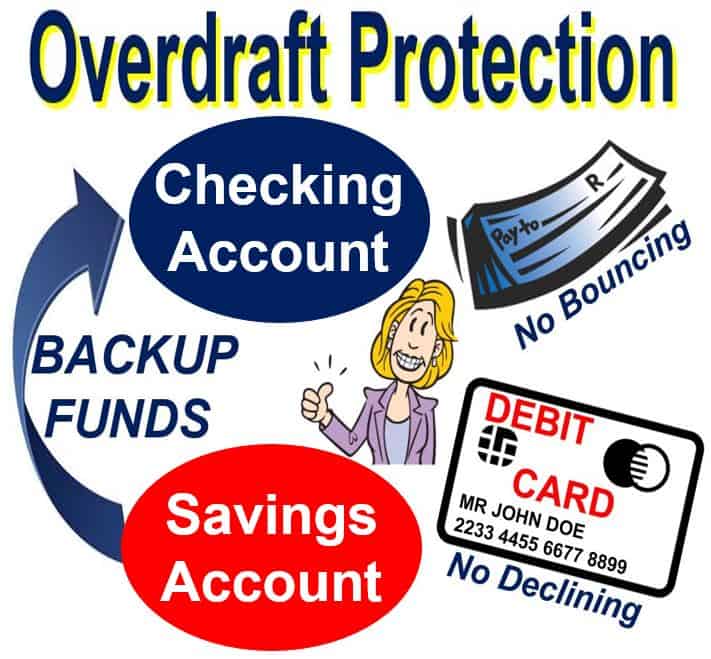Overdraft protection is an arrangement with your bank that does not penalize you with extra charges, bounce your check (UK: check) or decline a debit card payment because it was for more than the actual account balance in your checking account (UK: current account), i.e. there were insufficient funds.
An overdraft occurs when your checking account balance goes into negative numbers, i.e. you owe the bank money. This could happen by accident, or deliberately if you have an ‘arranged overdraft’.
If you sign up for overdraft protection, the bank will link your checking and savings accounts, and arrange for funds to be transferred from one account to the other to back up any transaction when there are insufficient funds to cover a check or payment.
The main advantage of overdraft protection is that if there are insufficient funds in your checking account, your check or debit card transaction will still go through regardless.
Are there charges with overdraft protection?
However, ask your bank whether they charge an overdraft fee to make the transfer, even though it is your own money they are using to cover the checking account deficit.
If you sign a check or make a debit card payment that is larger than the available funds in your savings account, the payment will probably not go through. Overdraft protection is not a limitless arrangement – you must ultimately have sufficient funds available.
Apart from a bit of embarrassment, it might not matter too much if your check bounces or the debit card payment is declined due to insufficient funds. However, in an emergency situation having a source of backup funds is vital. Imagine you get hit by a car abroad and have no international health or travel insurance and need emergency medical treatment.
In some rare cases, having your debit card payment declined might be much more serious and devastating than just ‘a bit of embarrassment’. Imagine you invite your boss for a meal when you are seeking promotion, or invite your fiancée’s parents to a restaurant and it is the first time you meet them.

“Overdraft protection is a service offered by banks that allows checking account holders to temporarily make purchases with a debit card even if they don’t have sufficient funds in their account to cover them.”
“In effect, the bank makes a short-term loan to the account holder so his debit card isn’t declined at the register or an ATM machine. In return, the bank charges an overdraft fee of $10 to $35, according to an informal Bankrate survey.”
Ad hoc overdraft coverage
Traditionally in the USA, the bank manager would look at the branch’s list of overdrafts each day and decide which ones to cover, even if no overdraft arrangement had been agreed – this would only be done with the bank’s favored customers.
Financial institutions did not traditionally charge for this ad hoc (informal, impromptu) coverage. The whole thing was done entirely at the manager’s discretion, i.e. customers, even the most reliable and favored ones, could not rely on it.
When large-scale interstate branch banking emerged, traditional ad hoc coverage gradually died off and hardly exists at all today.
‘Force pay’ lists still exist in US banks today. At the start of each business day, the branch manager receives a computerized list of items that are pending approval or rejection, only for accounts held at that branch, city or state.
Generally, if the customer can make a transfer to cover the amount of the item pending rejection, or is able to physically come into the branch with cash, the manager may ‘force pay’ the item. Also, if there are extenuating circumstances or the customer is super-reliable and well known, the manager may decide to ‘force pay’ it. However, this is becoming increasingly less common.
If a manager’s ‘force pay’ list included a check for $10 written out by Bill Gates, the founder of Microsoft, he or she would definitely force pay it – if it were rejected, that manager would probably get some very angry phone calls from senior management.
Video – What is Overdraft Protection?
Check out this video from Marketing Business Network, our sister channel in YouTube.
